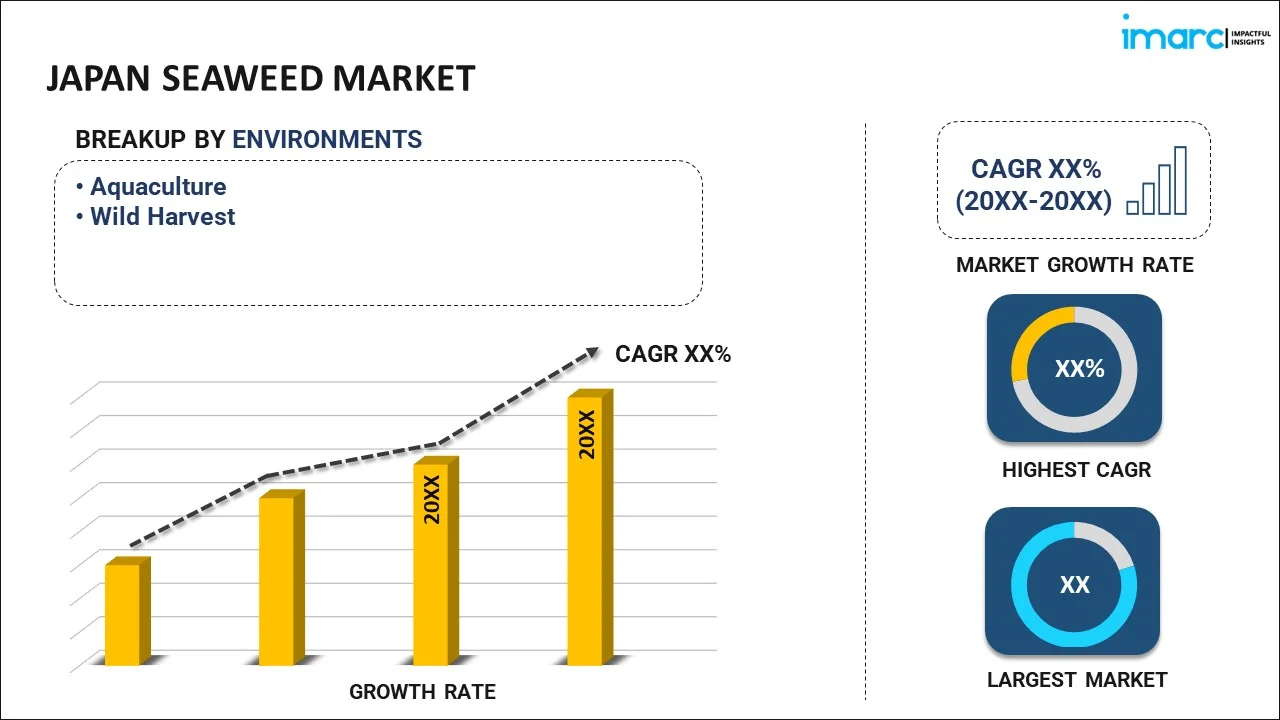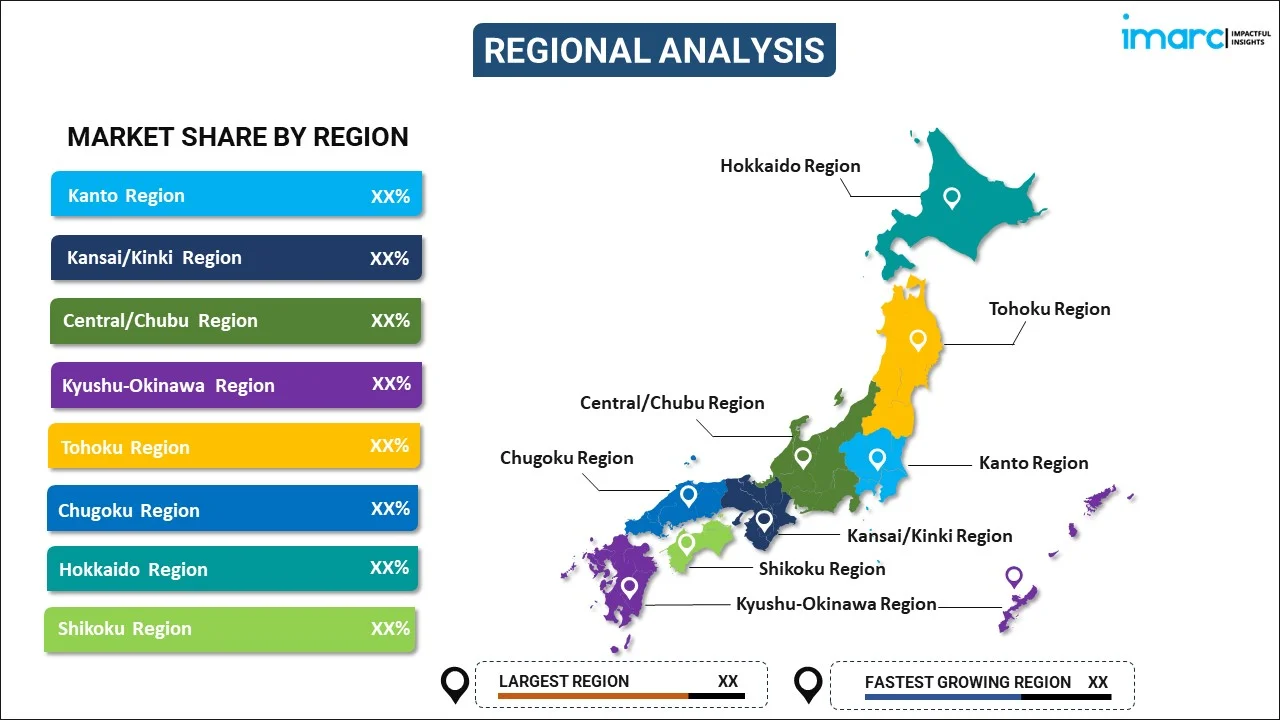
Japan Seaweed Market Report by Environment (Aquaculture, Wild Harvest), Product (Red, Brown, Green), Application (Processed Foods, Direct Human Consumption, Hydrocolloids, Fertilizers, Animal Feed Additives, and Others), and Region 2025-2033
Market Overview:
Japan seaweed market size is projected to exhibit a growth rate (CAGR) of 7.2% during 2025-2033. The rising consumer inclination towards plant-based diets and alternative protein sources, along with the widespread adoption of sustainable food options, is primarily augmenting the regional market.
|
Report Attribute
|
Key Statistics
|
|---|---|
|
Base Year
|
2024 |
|
Forecast Years
|
2025-2033 |
|
Historical Years
|
2019-2024
|
| Market Growth Rate (2025-2033) | 7.2% |
Seaweed, a type of marine algae thriving in oceans, seas, and lakes, constitutes a diverse group comprising thousands of species, such as red, brown, and green seaweed among them. These multicellular organisms lack true roots, stems, or leaves but anchor themselves to substrates like rocks using specialized structures called holdfasts. Serving a pivotal role in marine ecosystems as primary producers, seaweeds utilize photosynthesis to convert sunlight and nutrients into organic matter. Their ecological importance extends to providing habitats and nourishment for a varied marine ecosystem, including fish, invertebrates, and mammals. Beyond ecological significance, seaweeds find numerous commercial applications. Harvested for human consumption, they contribute to an array of products, including food, cosmetics, fertilizers, and pharmaceuticals. Furthermore, their potential as a renewable source of biofuel, with the capacity for conversion into bioethanol or other energy forms, adds to their multifaceted significance.
Japan Seaweed Market Trends:
In Japan, the seaweed market is flourishing due to a confluence of cultural heritage, health-conscious consumer trends, and innovative applications. Seaweed, deeply ingrained in Japanese cuisine, experiences a surge in popularity as a superfood, rich in minerals, vitamins, and umami flavor. Additionally, its role extends beyond traditional dishes, with seaweed becoming a key ingredient in contemporary snacks, condiments, and health products. Besides this, the nation's aging population and the pursuit of a healthy lifestyle contribute to the increased demand for seaweed-based products, driven by its recognized nutritional benefits, which is positively influencing the regional market. Furthermore, Japan's commitment to sustainable practices sees the rise of eco-friendly seaweed cultivation methods. As Japanese culinary influences continue to permeate global markets and consumers seek nutritious alternatives, the seaweed market in Japan stands as a dynamic blend of tradition, health consciousness, and culinary innovation. The versatile application of seaweed in snacks, soups, and even beverages showcases its adaptability to diverse culinary experiences. As Japan continues to blend tradition with innovation, the regional market is expected to bolster over the forecasted period.
Japan Seaweed Market Segmentation:
IMARC Group provides an analysis of the key trends in each segment of the market, along with forecasts at the country level for 2025-2033. Our report has categorized the market based on environment, product, and application.
Environment Insights:

- Aquaculture
- Wild Harvest
The report has provided a detailed breakup and analysis of the market based on the environment. This includes aquaculture and wild harvest.
Product Insights:
- Red
- Brown
- Green
A detailed breakup and analysis of the market based on the product have also been provided in the report. This includes red, brown, and green.
Application Insights:
- Processed Foods
- Direct Human Consumption
- Hydrocolloids
- Fertilizers
- Animal Feed Additives
- Others
The report has provided a detailed breakup and analysis of the market based on the application. This includes processed foods, direct human consumption, hydrocolloids, fertilizers, animal feed additives, and others.
Regional Insights:

- Kanto Region
- Kansai/Kinki Region
- Central/ Chubu Region
- Kyushu-Okinawa Region
- Tohoku Region
- Chugoku Region
- Hokkaido Region
- Shikoku Region
The report has also provided a comprehensive analysis of all the major regional markets, which include Kanto Region, Kansai/Kinki Region, Central/ Chubu Region, Kyushu-Okinawa Region, Tohoku Region, Chugoku Region, Hokkaido Region, and Shikoku Region.
Competitive Landscape:
The market research report has also provided a comprehensive analysis of the competitive landscape. Competitive analysis such as market structure, key player positioning, top winning strategies, competitive dashboard, and company evaluation quadrant has been covered in the report. Also, detailed profiles of all major companies have been provided.
Japan Seaweed Market Report Coverage:
| Report Features | Details |
|---|---|
| Base Year of the Analysis | 2024 |
| Historical Period | 2019-2024 |
| Forecast Period | 2025-2033 |
| Units | Million USD |
| Scope of the Report | Exploration of Historical Trends and Market Outlook, Industry Catalysts and Challenges, Segment-Wise Historical and Future Market Assessment:
|
| Environments Covered | Aquaculture, Wild Harvest |
| Products Covered | Red, Brown, Green |
| Applications Covered | Processed Foods, Direct Human Consumption, Hydrocolloids, Fertilizers, Animal Feed Additives, Others |
| Regions Covered | Kanto Region, Kansai/Kinki Region, Central/ Chubu Region, Kyushu-Okinawa Region, Tohoku Region, Chugoku Region, Hokkaido Region, Shikoku Region |
| Customization Scope | 10% Free Customization |
| Post-Sale Analyst Support | 10-12 Weeks |
| Delivery Format | PDF and Excel through Email (We can also provide the editable version of the report in PPT/Word format on special request) |
Key Questions Answered in This Report:
- How has the Japan seaweed market performed so far and how will it perform in the coming years?
- What has been the impact of COVID-19 on the Japan seaweed market?
- What is the breakup of the Japan seaweed market on the basis of environment?
- What is the breakup of the Japan seaweed market on the basis of product?
- What is the breakup of the Japan seaweed market on the basis of application?
- What are the various stages in the value chain of the Japan seaweed market?
- What are the key driving factors and challenges in the Japan seaweed?
- What is the structure of the Japan seaweed market and who are the key players?
- What is the degree of competition in the Japan seaweed market?
Key Benefits for Stakeholders:
- IMARC’s industry report offers a comprehensive quantitative analysis of various market segments, historical and current market trends, market forecasts, and dynamics of the Japan seaweed market from 2019-2033.
- The research report provides the latest information on the market drivers, challenges, and opportunities in the Japan seaweed market.
- Porter's five forces analysis assist stakeholders in assessing the impact of new entrants, competitive rivalry, supplier power, buyer power, and the threat of substitution. It helps stakeholders to analyze the level of competition within the Japan seaweed industry and its attractiveness.
- Competitive landscape allows stakeholders to understand their competitive environment and provides an insight into the current positions of key players in the market.
Need more help?
- Speak to our experienced analysts for insights on the current market scenarios.
- Include additional segments and countries to customize the report as per your requirement.
- Gain an unparalleled competitive advantage in your domain by understanding how to utilize the report and positively impacting your operations and revenue.
- For further assistance, please connect with our analysts.
 Inquire Before Buying
Inquire Before Buying
 Speak to an Analyst
Speak to an Analyst
 Request Brochure
Request Brochure
 Request Customization
Request Customization




.webp)




.webp)












